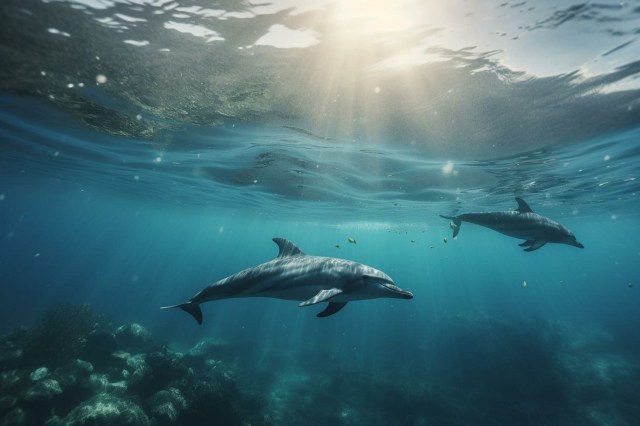
Dolphins are known for their intelligence, social behavior and remarkable communication skills. These majestic creatures have captivated the human imagination for centuries. But how do dolphins communicate underwater? In this article, we’ll delve into the fascinating world of dolphin communication and explore the different methods they use to interact with each other beneath the waves.
Vocalizations
Underwater, dolphins rely heavily on vocalizations to communicate with each other. These vocalizations can take a variety of forms, including clicks, hisses, and pulsing sounds. One of the most common types of vocalization is the echolocation click. Dolphins emit a series of rapid clicks that bounce off objects in their environment and provide them with valuable information about their surroundings.
Whistles are another important form of vocalization used by dolphins underwater. Each dolphin has its own unique whistle that serves as its individual signature or “name.” Whistles allow dolphins to identify each other and maintain contact within their social groups. Dolphins also use whistles during courtship displays or when they want to convey a specific message to other members of their group.
While vocalizations play an important role in dolphin communication underwater, body language is just as important. Dolphins use a variety of gestures and physical movements to convey messages to each other. For example, they may swim synchronized or jump out of the water to demonstrate unity within their group.
Tail slapping is another common form of body language used by dolphins underwater. When a dolphin bangs its tail against the water surface, it may signal aggression or territoriality toward other dolphins or potential threats nearby. On the other hand, light nudging or rubbing between individuals indicates affection and social bonding.
Click on Communication
In addition to echolocation clicks used for navigation purposes, dolphins also use click communication to transmit specific messages. Click-through communication involves producing distinct click patterns with different meanings. These clicks may indicate warnings, requests for support, or even social greetings.
Research has shown that dolphins have a remarkable ability to understand and interpret clicking communications from other individuals within their group. They can distinguish different click patterns and respond accordingly, showcasing their highly developed cognitive abilities.
Complex social structure
Dolphins’ communication underwater is also influenced by their complex social structure. Dolphins live in groups called pods, made up of several individuals. Within these groups, there are hierarchies and social bonds that shape how dolphins interact with each other.
Dominant males often play a crucial role in leading the group and maintaining order within the group. They use vocalizations, body language, and physical contact to assert dominance and establish their position within the hierarchy. Other group members follow these cues to effectively navigate their social interactions.
In conclusion, underwater dolphin communication is a fascinating subject that highlights the intelligence and social complexity of these marine mammals. Through vocalizations, body language, click communication, and a complex social structure, dolphins are able to communicate effectively with each other beneath the waves. Understanding how dolphins communicate can provide valuable information about their behavior and improve our appreciation of these incredible creatures.
This text was generated using a large language model, and selected text has been edited and moderated for purposes such as readability.
